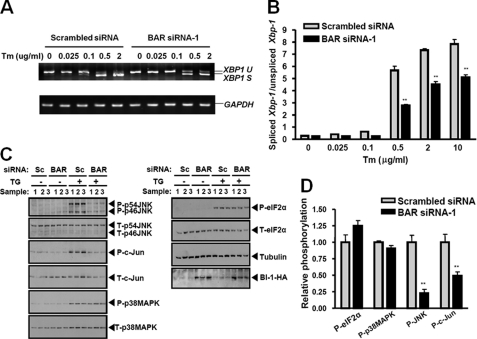FIGURE 7.
BAR knockdown modulates ER stress-induced IRE1 signaling. A, BI-1-expressing HeLa cells were transfected with scrambled siRNA or BAR siRNA-1. After 24 h, cells were treated with 500 ng/ml of doxycycline for 24 h to induce BI-1 expression. Cells were then treated with increasing concentrations of tunicamycin as indicated for 2.5 h. The levels of XBP1 mRNA splicing were determined by RT-PCR. Spliced XBP1 (XBP1 S) and unspliced XBP1 (XBP1 U) were indicated. Glyceraldehyde-3-phosphate dehydrogenase (GAPDH) mRNA level was determined by RT-PCR. B, the levels of spliced XBP1 and unspliced XBP1 after tunicamycin treatment were also determined by real time PCR. The ratios of spliced XBP1/unspliced XBP1 were calculated. Statistical significance (mean ± S.E.; n = 3) was determined by Student's t test, and is denoted by asterisks (**, p < 0.01). C, BI-1-expressing HeLa cells were transfected with scrambled siRNA (Sc) or BAR siRNA-1. After 24 h, cells were treated with 500 ng/ml of doxycycline for an additional 24 h to induce BI-1 expression. Cells were then treated with 5 μm thapsigargin (TG) for 1 h. Cell lysates were analyzed by immunoblotting with antibodies to various ER stress markers, HA epitope, and α-tubulin. The blot was first probed with antibody to the phosphoprotein, followed by antibody stripping and probing with phospho-independent antibody directed to the same protein. Additionally, the blot was re-probed with anti-BAR antibody confirming the results shown in Fig. 6A (not shown). D, scanning densitometry was performed and the ratios were determined of phosphoprotein:total protein corresponding to various ER stress markers. The ratios in the scrambled siRNA group were adjusted to 1. Statistical significance (mean ± S.E.; n = 3) was determined by Student's t test, and is denoted by asterisks (**, p < 0.01).

